Walking is in crisis. The number of journeys made by foot has been falling for decades, and the trend shows no sign of abating. In a culture that advocates constant efficiency, the humble walk is anachronistic. Why walk when you can hail a self-driving Uber to your high-intensity gym class? Walking may be free and eco-friendly, but it’s hardly cool.
All of which is why Living Streets, the “charity for everyday walking”, is fighting to reassert bipedal power. It has designated May as National Walking Month. It urges us to “Try 20”, and find 20 minutes a day for a walk.
“We are not the ramblers,” says the charity’s Kathryn Shaw. “It’s about encouraging people, particularly the over-35s, to build walking into their daily lives. The chief medical officer recommends that we are active for 150 minutes a week. But figures show that as little as 6% of the population achieve that. We have found ways to engineer walking out of our lives.”
It is tempting to think that, like chefs forced to come up with meals you can cook in ever-smaller windows of time, exercise mandarins are simply lowering their ambitions. If the nation’s blobbies can’t be cajoled on to a treadmill, perhaps they could be coaxed into walking around the block.
Yet while walking won’t give you an eight-pack, it can reduce the risk of heart disease, stroke and diabetes, alleviate depression, and improve productivity at work. You might still look bad, but you’ll feel better.
Nor does the scenery make any difference. In a previous job my pedestrian commute in London took me through Primrose Hill, Regent’s Park, Green Park and St James’s Park. Gorgeous. I could watch the London Zoo giraffes have their breakfast and wonder if anyone in the capital was smugger. My new route to the Observer, by comparison, goes through an estate, uphill along a roaring three-lane A-road and past two prisons. The effect on my mood is just the same.
Urban walking is hardly new. Novelist and journalist Will Self has long played the townie flâneur, and writer Iain Sinclair has made a fine reputation from his various London peregrinations. But they always come with a lecture: a walk isn’t a real walk unless you are aware of the history in every paving stone.
Wading through all that history is exhausting. Even if you’re not constantly nostalgic for the streets as they were before, there’s a presumption – I blame the ramblers – that walking ought always to be a kind of Wordsworthian reverie, meditative and inspirational.
In reality there has never been a better time to be a daily walker, thanks in part to technology. In the past it was hard for walk bores to persuade everyone that it really was quicker to walk than take the bus. Thanks to apps like Citymapper and Google Maps, I can now prove my point in seconds.
I can catch up with correspondence, listen to music, watch TV, take photos of interesting things and broadcast them to the world, all the while clocking up valuable active minutes.
In the German city of Augsburg, the council has even embedded traffic lights in the pavement. Phone users don’t have to lift their eyes for even a second. Vorsprung durch Technik. Progress: eyes down, one foot in front of the other.
London
by Ed Cumming
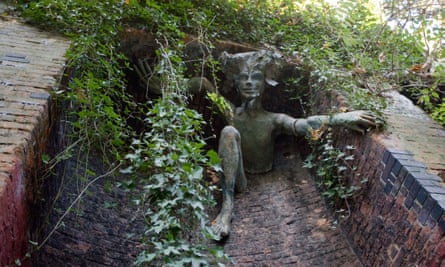
Everyone bangs on about the High Line in New York [a public park built on a historic freight rail line elevated above the streets of the city’s West Side] but there is an equivalent in London and it is one of my favourite walks.
It is in Haringey, north London, and is part of the Parkland Walk local nature reserve. The southern route starts in Finsbury Park, from where you then head north-west up the old railway line towards Highgate. Apart from the graffiti and the skate ramp, you could be in the countryside. Halfway along is the overgrown abandoned Crouch Hill railway station. Very atmospheric.
At the end, you can carry on to Alexandra Palace or round to Highgate cemetery to look at various celebrity graves. For me, artist Patrick Caulfield’s is the best.
Bristol
by Luke Sargeant, Walking Bristol
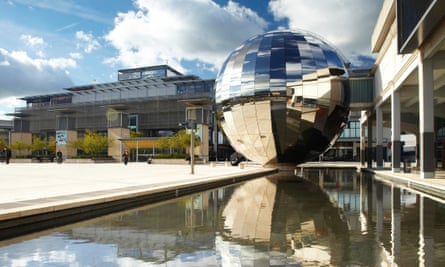
I’d start in St Nicholas market. It’s the old city centre of Bristol. Then walk along Welsh Back and past a pub called the Llandoger Trow. It’s said that Daniel Defoe met the inspiration for Robinson Crusoe, Alexander Selkirk, there, so that’s quite cool.
Head on to Queen Square, the largest Georgian square outside of London and also the site of the first American embassy. Then past the harbour, where Pero’s bridge is a reminder of the city’s links to the slave trade. In Millennium Square there is a solar tree where you can charge your phone for free – a hangover from the 2015 Bristol Green Capital.
Carry on round the river where you can see a replica of The Matthew, the ship in which John Cabot sailed to North America in 1497, and Brunel’s SS Great Britain, the “ship that changed the world”.
Glasgow
by Patricia Clark, Greetin Glasgow
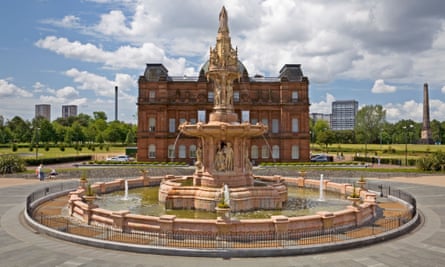
Glasgow is quite spread out, so in a half-hour walk you need to keep to quite a small area. Start in George Square, right in the centre. The city chambers are there, one of the most ornate buildings in the country, built as a monument to Queen Victoria. The square is one of the oldest public spaces and was the scene of the Black Friday riot in 1919, over shorter working hours.
Head up to Royal Exchange Square, then follow Buchanan Street all the way to the bottom, by the river. Take a left and walk in a line along the river, and keep going until the gates of Glasgow Green, which is a huge park and has the same feel as Central Park in New York. Nearby is the People’s Palace museum and the Templeton building.
Bath
by Alison Barran, Mayor’s Guides
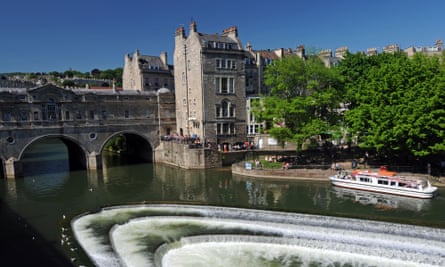
Start from Pulteney weir and cross the famous Robert Adam-designed Pulteney bridge which, like the Ponte Vecchio [in Florence], has shops along it.
Walk down the elegant Great Pulteney Street, designed by Thomas Baldwin, and part of a larger development planned for that area. The greater part of that development was never finished as, Baldwin was bankrupted in the Napoleonic wars. At the end of the street is the Holburne museum and behind this is Sydney Gardens, where Jane Austen used to stroll. There is a plaque to her at 4 Sydney Place, opposite the museum.
Walk down one side of Great Pulteney Street and return on the other, looking at the bronze plaques of famous people who have stayed in some of the houses, from Wilberforce to Napoleon III.
Brighton
by Julian Clapp, Brighton City Walks
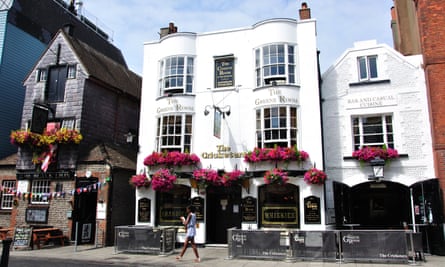
Start at Brighton Pier, and take in the old West Pier in the distance, crumbling sadly into the sea, and admire the British Airways i360 tower rising into the sky.
Cross Kings Road and wander up East Street into the Old Steine area, where there are lovely Victorian homes and gardens, then cut through to the fishermen’s cottages from the 1500s.
Continue to the Cricketers, the oldest pub in Brighton, and go on into Black Lion Lane and Ship Street Gardens. Head past the old Hippodrome and into the old Lanes area. Then stop for coffee and cake.
Manchester
by Anne Bevick, Manchester Guided Tours
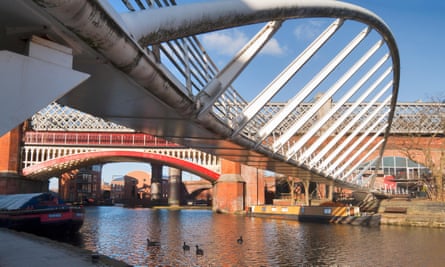
A lot of people work in Spinningfields, but if you’re around there you can leave the area and go for a walk around Castlefield, five minutes away.
By taking a short loop you can check out the Giant’s Basin, which is the overflow from the canal that goes into the river Medlock, and also the world’s first passenger railway station, at the Museum of Science and Industry.
It’s a circular route and you can end up in St John’s Gardens, where you can eat your lunch. You can see everything from the city’s Roman origins – they called it Mamucium, which means breast-shaped mound; it’s always been a sexy place to be – to the origins of the industrial revolution. You’ll be back in time to start the afternoon.
Cardiff
by Paul Harris, Cardiff On Foot
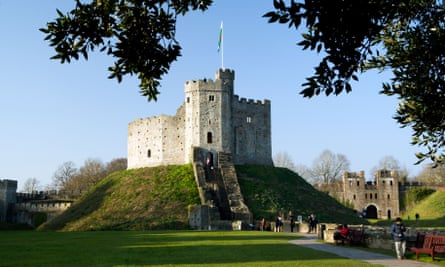
Wherever else we take our walking tours, the last half hour is always spent exploring the castle. It’s a serene route, all off-road, away from the hubbub of the city.
Start at Cardiff Castle’s main entrance and head east down the “animal wall”, which features animal sculptures that were created in the 19th century.
Then you come around the back to the arboretum, which extends five miles out to the edge of the city. There are champion trees from all over the world: Siberian elms, Japanese maples, the list goes on.
After the arboretum you come around towards the civic centre, and there are fantastic views of the Victorian development, and the canals that helped to bring coal down from the valleys.
Leeds
by Ken Goor, Goors Guiding
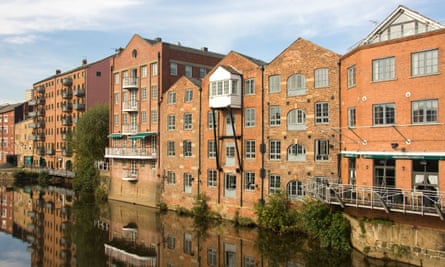
Start at the Corn Exchange and walk down towards the river, to the gate area, then over the river Aire by Bridge End. Turn left on to Dock Street and left again into the housing development on Victoria Quays, where the old docks have been preserved.
Carry on to the old Tetley’s Wharf, Brewery Wharf, and then over the Centenary Bridge on to The Calls. Go under the railway arch back up towards the Corn Exchange, turn right to Leeds Kirkgate Market, which is the largest covered market in Europe, and on to King Edward Street. Then into Victoria Quarter, to the County Arcade and Queens Arcade. That whole area was designed by the theatre architect Frank Matcham, who also designed the London Palladium.
Birmingham
by Sue Behan, Birmingham Tours
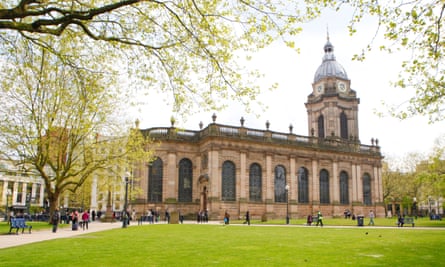
This takes in five squares, with a pint at the end. Start in the Eastside city park, which opened in 2011, the first new park in 130 years. Drop in at St Martin’s church to see the oldest monuments in the city – the tombs of the de Birmingham family. Then pass the Rotunda and the Bull, all five bronze tonnes of him.
In St Philip’s cathedral you can see the windows designed by Edward Burne-Jones, and the tomb of the “Kingdom’s smallest woman”, Nanette Stocker. Then over the Great Charles Street bridge and on to Golden Square. There’s a pen-nib imprint on the floor, a reminder of the time when two-thirds of the world wrote with a pen made in Birmingham.
Retrace your steps to Victoria Square and Chamberlain Square, and on through Centenary Square, passing the “golden boys” statue, and finally along the towpath to the Mailbox mall for some refreshment.
Edinburgh
by Stuart Usher, Edinburgh Guided Tour
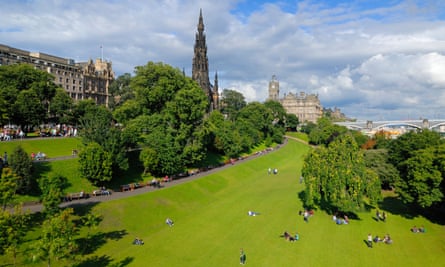
Start off in Princes Street, where most of the shops and hotels are. Head up the Mound and then on to the Royal Mile, which connects Holyrood with the Old Town. It’s well named, just over a mile in length.
St Giles’ cathedral will be right in front of you, so you can walk around it, but also there are several important statues, including of Adam Smith, the economist, and David Hume, the philosopher. Between them they were central to the development of the modern western world. You can pass Hume’s house and see where he lived.
Then up to the esplanade of the castle, where James VI of Scotland was born. After that you look northwards to a small gate and walk down a long flight of winding steps back to Princes Street gardens.
